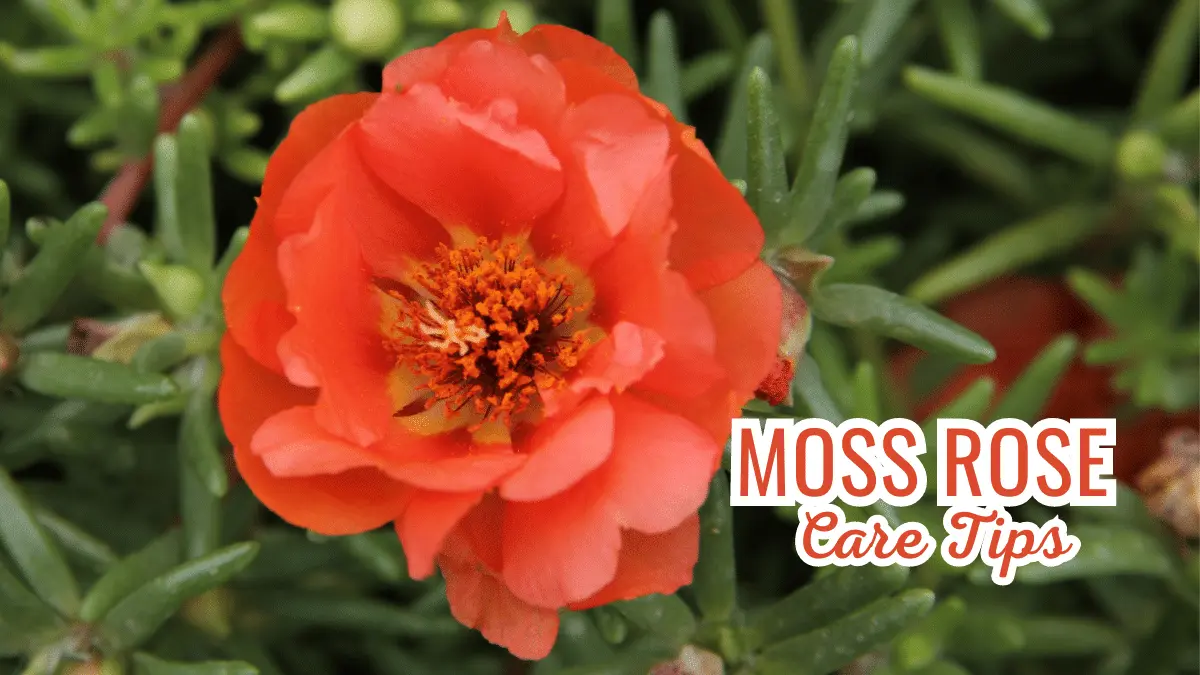We use affiliate links to run our site. When you buy through links on our site, we may earn an affiliate commission, without any added cost to you. Learn more
With its jewel-toned flowers and trailing habit, moss rose brings charm and color to gardens everywhere.
But did you know this heat-loving annual has an intriguing past and unique traits that set it apart? There’s more to this pretty plant than meets the eye.
Join us as we dig deeper into the versatile moss rose and discover why it deserves a spot in your landscape.
What is Moss Rose?
The moss rose, also called Portulaca grandiflora, belongs to the Portulacaceae family along with purslane. This low-growing annual plant is native to Argentina, southern Brazil, and Uruguay.
It thrives in hot, dry areas. The succulent leaves and stems allow it to endure drought. Moss rose grows 3-9 inches tall and spreads readily to form a lush ground cover.
Its flowers come in a mix of colors like red, orange, pink, yellow, white, and purple. They have a satiny texture and delicate ruffled form.
Ideal Growing Conditions
Moss rose prefers full sunlight and dry, sandy soil. Good drainage is key, as it will rot in wet conditions. Moss rose actually prefers poor soil and requires little feeding. It thrives in heat up to 95 Fahrenheit.
Plants go dormant in extreme heat over 100 F. Cooler temps below 50 F can cause moss rose to decline. These plants handle drought very well once established. Water them sparingly, only when the soil is completely dry.
Uses in the Garden
With its carpet-like growth and colorful flowers, moss rose makes an attractive ground cover or edging plant. It cascades nicely over walls and containers too. Try planting moss rose in rock gardens, borders, Raised beds, or accent pots.
It mixes well with ornamental grasses, perennials, and annuals like verbena andalyssum. For the best flower power, pinch off spent blooms to encourage new buds.
Moss rose self-seeds readily under ideal conditions.
Growing From Seed
It’s easy to grow moss rose from seed. Sow seeds directly in the garden after the last frost. Choose a site with full sun and well-drained soil.
Rake the soil smooth and scatter seeds atop the soil surface. Do not bury them.
Water gently and maintain even moisture until sprouts emerge in 1-2 weeks. Thin seedlings 8-12 inches apart.
Caring for Moss Rose
Once established, moss rose requires minimal care besides occasional watering. It flourishes when ignored, with no need for deadheading or fertilizing.
Prune lightly in summer to shape plants. Shear off spent flower stems to encourage new blooms. Always allow the soil to dry out between waterings.
Avoid wetting the foliage, as it can develop fungal diseases in humid conditions. Spread a thin mulch around plants to help retain soil moisture and reduce weeds.
Unique Attributes
One signature trait of moss rose is its flowers that close at night or on cloudy days. The brilliant blossoms unfurl in the morning sunlight, providing a daily spectacle.
The moss rose gets its name from the clumped, moss-like flower form. The ruffled, crepe-textured petals have a delicate appearance.
Plants spread readily on fleshy stems that root where they touch the ground.
Rose Bush Care Tips: How To Grow Roses Effortlessly
Compact Habit
The low, mounded form makes moss rose perfect for edging, containers, and cascading over stone. It stays tidy and compact compared to other creeping plants.
The dense mat of foliage and flowers choke out weeds. As an annual, it’s easy to control moss rose from spreading too far. Just pull up unwanted growth.
For a continuous flower display, sow new seeds every 2-3 weeks until mid-summer.
Pet Safety
When planted outdoors, it’s important to note that moss rose contains toxins that can cause vomiting and diarrhea if ingested by dogs or cats.
Keep pets away from areas where moss rose is growing.
Choose safer alternatives like marigolds and coreopsis if children or animals will be interacting closely with the garden space.
How to Make A Pet Friendly Garden
Versatile and Vibrant
Few plants offer the vibrant, non-stop color of moss rose with so little maintenance. It thrives where many other flowers falter, rewarding gardeners with cheery blooms even in hot, dry conditions.
For an effortless yet eye-catching display, look no further than the vibrant moss rose. This delicate-looking annual is a powerhouse of color and drought tolerance for gardens everywhere.
Conclusion:
Moss rose punches above its weight when it comes to beauty and versatility. Hopefully, you’ve discovered a new appreciation for this delightful flower and its low-maintenance, vibrant impact.
For more tips on growing moss rose and other drought-tolerant plants, explore the gardening articles on our site.
Don’t forget to share this guide with fellow gardeners who could benefit from moss rose’s charms. Most importantly, be inspired to add a pop of color to your garden with moss rose this season!
Amazon and the Amazon logo are trademarks of Amazon.com, Inc, or its affiliates.

Hi there! My name is Prasenjit and I’m an avid gardener and someone who has grown a passion for growing plants. From my hands-on experience, I have learned what works and what doesn’t. Here I share everything I have learned.
